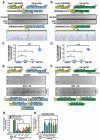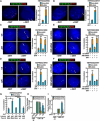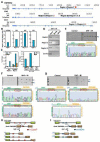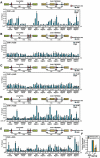Nuclear receptor-induced chromosomal proximity and DNA breaks underlie specific translocations in cancer
- PMID: 19962179
- PMCID: PMC2812435
- DOI: 10.1016/j.cell.2009.11.030
Nuclear receptor-induced chromosomal proximity and DNA breaks underlie specific translocations in cancer
Abstract
Chromosomal translocations are a hallmark of leukemia/lymphoma and also appear in solid tumors, but the underlying mechanism remains elusive. By establishing a cellular model that mimics the relative frequency of authentic translocation events without proliferation selection, we report mechanisms of nuclear receptor-dependent tumor translocations. Intronic binding of liganded androgen receptor (AR) first juxtaposes translocation loci by triggering intra- and interchromosomal interactions. AR then promotes site-specific DNA double-stranded breaks (DSBs) at translocation loci by recruiting two types of enzymatic activities induced by genotoxic stress and liganded AR, including activation-induced cytidine deaminase and the LINE-1 repeat-encoded ORF2 endonuclease. These enzymes synergistically generate site-selective DSBs at juxtaposed translocation loci that are ligated by nonhomologous end joining pathway for specific translocations. Our data suggest that the confluence of two parallel pathways initiated by liganded nuclear receptor and genotoxic stress underlies nonrandom tumor translocations, which may function in many types of tumors and pathological processes.
Figures







Comment in
-
The dangers of transcription.Cell. 2009 Dec 11;139(6):1047-9. doi: 10.1016/j.cell.2009.11.037. Cell. 2009. PMID: 20005797 Free PMC article.
References
-
- Aguilera A, Gomez-Gonzalez B. Genome instability: a mechanistic view of its causes and consequences. Nat Rev Genet. 2008;9:204–217. - PubMed
-
- Aravin AA, Sachidanandam R, Girard A, Fejes-Toth K, Hannon GJ. Science. Vol. 316. New York, NY: 2007. Developmentally regulated piRNA clusters implicate MILI in transposon control; pp. 744–747. - PubMed
-
- Berkovich E, Monnat RJ, Jr., Kastan MB. Assessment of protein dynamics and DNA repair following generation of DNA double-strand breaks at defined genomic sites. Nature protocols. 2008;3:915–922. - PubMed
Publication types
MeSH terms
Substances
Grants and funding
LinkOut - more resources
Full Text Sources
Other Literature Sources
Medical
Molecular Biology Databases
Research Materials

